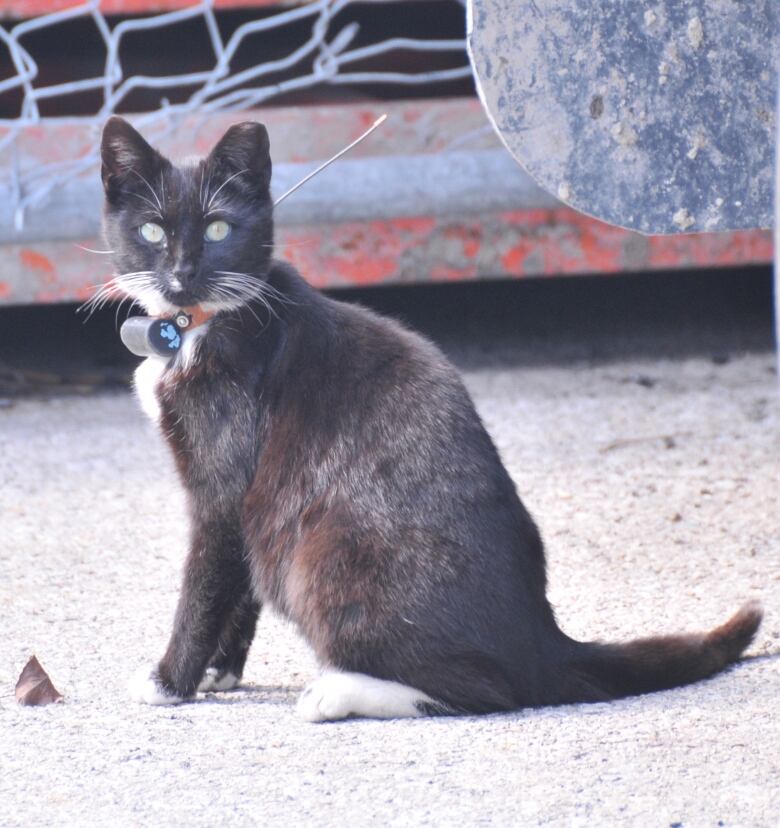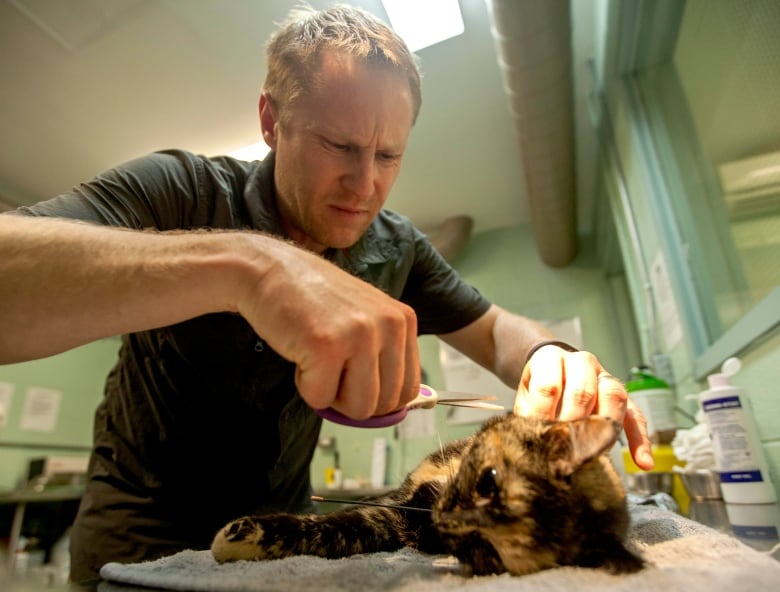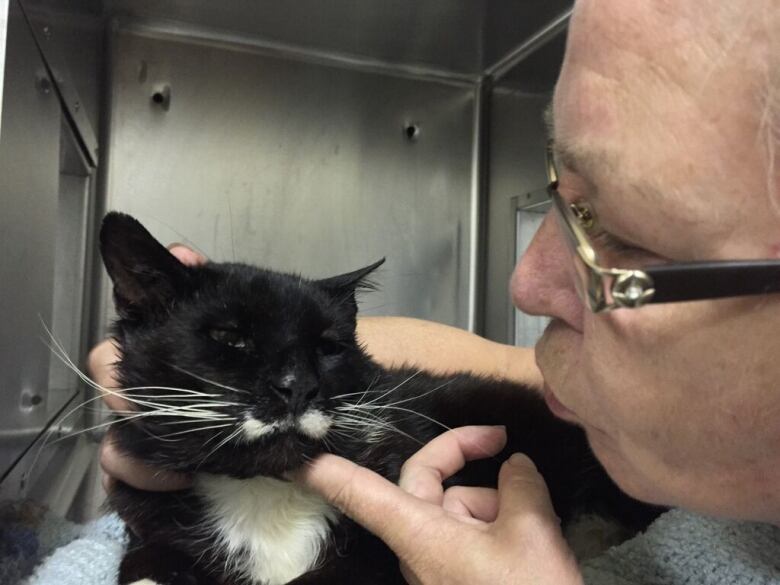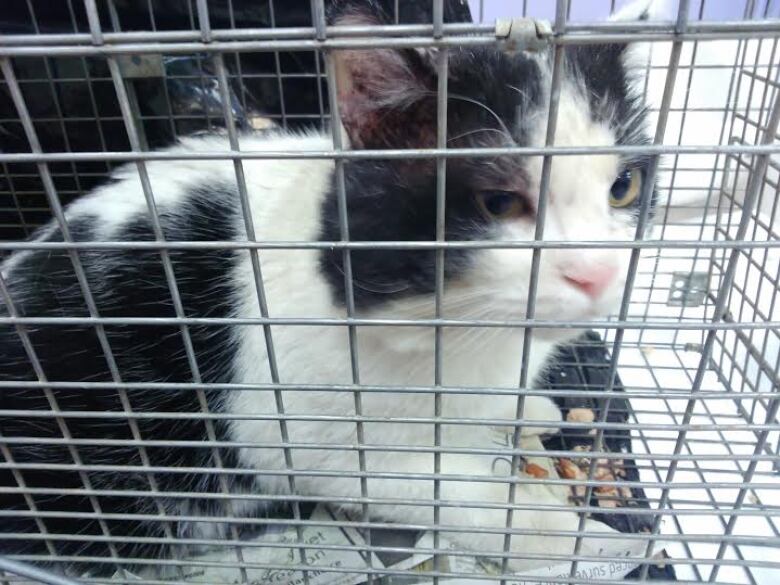Stray cat research hopes to curtail feline overpopulation
One of the biggest problems is no one really knows how many feral cats there are
The black-and-white cat let's call her Mittens doesn't look much like a stray.
She's not scruffy. There's no big, gapinggash in her ear that could have come from a fight with another wayward feline she met while wanderingin Toronto.

Mittens wasmonitored recentlyas part of a research project by University of Guelph wildlife ecologist Tyler Flockhart. The post-doctoral fellow put radio collars on her and 31 other feral cats in Toronto and Guelph as part of an effortto find ways to help municipalities deal with Canada's burgeoning cat population.
A 2012 report by the Canadian Federation of Humane Societies estimated the number of owned cats in Canada at 10.2 million which is roughly one cat for every three Canadians.
In addition, there were anestimated 600,000 cats in shelters in 2011 thatdid not get placed in homes, the federation said. And random estimates from communities across the country suggest there are tens of thousands of cats roaming in individual cities or towns.
- Cats, the No. 1 killer of birds in Canada
- 'Cat crisis' erupts in Surrey
- Toronto embarks on targeted trap, spay/neuter, return program
In some places,it's been called a "crisis."In Toronto alone,the estimate of stray and feral felines was around 100,000 late last year.
Just doesn't work
"People are looking for solutions and quite often those solutions need to deviate from what's been done over the past 30, 50, 60 years," says Flockhart, referring to euthanasia of those catsthat aren't adopted out of shelters, a practice thatnow seems to be falling out of public favour.

"A good scientific look at history would tell us that that model just simply doesn't work," says Shane Bateman, a veterinarian and chair of the board of the Guelph Humane Society.
"There are probably more cats today than there have ever been, and so euthanizing and trying to get ahead of the population explosion that way just simply isn't a good option, and it's a very, very unpalatable option for communities these days who are more and more concerned about animal welfare."
- Euthanized cats in Kings County upset animal activists
- 6-legged street cat awaits surgery, then adoption
But figuring out what do next isn't easy, particularly when there's no good sense of exactly how many feral cats there are in Canada.
"Everybody has an opinion and sometimes those opinions can be very passionate and that only adds to the challenge around this work," says Bateman, who is also a clinical studies professor at the University of Guelph.
The problems caused by feral cats range from nuisance messed-up flower beds and howling in the night to ecological. Some estimates suggest cats may be responsible for the deaths of hundreds of millions of songbirds a year in Canada.
Concerns have also been raised about the possible public health implications of a disease cats can carry toxoplasmosis not to mentionthewelfare of the animals themselves, an issue thatBateman says has found significant public support in recent years.
Fix them and put them back
In Guelph, a cat population task force has been formed to look at strategies to deal with the overpopulation problem. The group draws together local organizations and several departments at the university.

Some Canadian communities and animal shelters have programs to trap feral cats, spay or neuter them and then return them to where they were found often in colonies.
Vancouver, for one, has done away with itsferal cat colonies, says Amy Morris, policy and outreach officer for the BC SPCA.
Inpartnership with the Vancouver Orphan Kitten Rescue Association, it has a program inwhich volunteers bring cats to the SPCA's hospital where spaying and neutering are done for free.
The BC SPCA shelter system has a waiting list and limited admission. Shelters elsewhere may takeany cat, and euthanize ones not quickly adopted.
"Both methods demonstratethat there is an overpopulation," says Morris. "There's more cats than homes."
In Toronto, the first targeted trap, spay/neuter and return program was launched late last year.
But Bateman says it is still too early to say what the best course of action is."Until we have more scientific information about the utility and importance of tools like trap-neuter-return or accessible or low-cost spay-neuter, it's difficult to know because these are huge resource-intensive programs and projects."
Flockhart's research aims to provide some of that information. Along with his work in trying to developa population model for cats, his efforts tracking feral cats in Toronto and Guelph hope to shed light on how cats survive and move throughout communities.
So far, he's been surprised to see they don't really wander that far, maybe just a block or so.
At an impasse
"We have pretty good information on the number of cats that come in and go out of animal shelters, but we don't know the number of cats on the street for sure, and we don't even really know the proportion of cats that have indoor-outdoor access," says Flockhart.
"These are really basic questions that require numbers so that we can address the magnitude of the risk and how we might address it."

Part of the solution may also lie in changing public perceptions around the common cat, an animal Morris and Bateman both say that has been treated differently from that other common pet, the dog, which is more likely to be spayed or neutered,have ID and be taken to the vet.
Bateman says there are stereotypes around cats for example, that they are bloodthirsty killers that are never really our friends that don't have much basis in fact.
For its part, the BC SPCA has a social science researcher looking into ways to develop more positive public messages aimed at people who might abandon cats or feed free-roaming ones.
Morris sees much value in developing a widespread messaging campaign "just like seatbelts save lives" that could help the idea of spaying and neutering cats become "one of those things that is ingrained in our culture."
And there is always the hope politicians could find a little more money to put toward the issue not an easy sell when there are competing demands for public funds.
"I think cities need to step up," says Maria Soroski, a co-founder of the Vancouver Orphan Kitten Rescue Association.
"I know it's very hard to give grants to cat rescue when there's homeless people and such, but the cat problem is a problem and there has to be some small amount of money put toward trap-neuter-return."












_(720p).jpg)


 OFFICIAL HD MUSIC VIDEO.jpg)
.jpg)



























































































